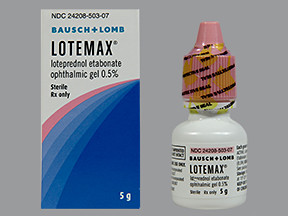LOTEPREDNOL GEL - OPHTHALMIC
PHONETIC PRONUNCIATION: (LOE-te-PRED-nol)
COMMON BRAND NAME(S): Lotemax
GENERIC NAME(S): loteprednol etabonate
Uses
USES: This medication is used to treat eye inflammation and pain after eye surgery. Loteprednol works by relieving symptoms such as swelling, redness, and itching. It belongs to a class of drugs known as corticosteroids.
How to use LOTEPREDNOL GEL - OPHTHALMIC
HOW TO USE: Do not wear contact lenses while you are using this medication. Sterilize contact lenses according to the manufacturer's directions, and check with your doctor before you begin using them again. To apply the eye gel, wash your hands first. To avoid contamination, do not touch the bottle tip or let it touch your eye or any other surface. Turn the bottle upside down and shake once to fill the tip with the gel. Gently pull down the lower eyelid to make a pouch. Place the prescribed number of drops into the pouch. Gently close the eye and roll the eyeball in all directions to spread the medication. Try not to blink or rub your eye. Repeat these steps for your other eye if so directed. If you are using another kind of eye medication (for example, drops, ointments, or other gels), wait at least 5 to 10 minutes before applying other medications. Use eye drops before eye ointments or gels to allow the drops to enter the eye. Use this medication regularly to get the most benefit from it. To help you remember, use it at the same times each day. Apply as directed by your doctor, usually 4 times a day. The dosage and length of treatment are based on your medical condition and response to treatment. Do not increase your dose or use this drug more often than prescribed. Your condition will not improve any faster, and your risk of side effects will increase. Continue to use this medication for the full time prescribed. Do not stop using this medication without consulting your doctor. Some conditions may become worse when this drug is suddenly stopped. Your dose may need to be gradually decreased. Do not use this product if it becomes contaminated (for example, the gel turns a dark color or develops particles in it). Using contaminated eye medication can cause infection, serious damage to the eye, and loss of vision. Ask your doctor or pharmacist for more information. Tell your doctor if your condition does not improve after a few days or if it worsens.
Side Effects
Precautions
Interactions
Overdose
Images
Reviews
Faq for LOTEPREDNOL GEL - OPHTHALMIC
- Loteprednol gel is used to treat eye inflammation and pain following eye surgery. It is also used to treat certain eye conditions such as conjunctivitis and uveitis.
- Loteprednol gel belongs to a class of drugs called corticosteroids. It works by reducing inflammation in the eye, thereby relieving pain, redness, and swelling.
- Wash your hands before applying the gel. Tilt your head back and pull down your lower eyelid to create a small pocket. Squeeze a thin strip of the gel into the pocket, then close your eyes gently and slowly roll your eyes in all directions to spread the gel. Do not touch the tip of the tube to your eye or any other surface.
- The recommended dosage is usually 1 or 2 drops of the gel in the affected eye(s) 2 to 4 times daily, or as directed by your doctor. Follow your doctor's instructions carefully.
- Common side effects include blurry vision, eye discomfort or irritation, increased eye pressure, and headache. If you experience any severe or persistent side effects, contact your doctor immediately.
- It is generally recommended to avoid wearing contact lenses while using Loteprednol gel. Consult your doctor for specific instructions.
- The onset of action varies depending on the specific eye condition being treated. In some cases, you may start experiencing relief within a few hours, while in other cases it may take a few days. Follow your doctor's recommendations and continue using the gel as prescribed.
- If you miss a dose, apply it as soon as you remember. However, if it's almost time for your next dose, skip the missed dose and continue with your regular dosing schedule. Do not apply a double dose to make up for a missed one.
- Loteprednol gel may interact with certain other eye medications. Inform your doctor about all the medications you are currently taking, including prescription, over-the-counter, and herbal products, to avoid any potential interactions.
Disclaimer
IMPORTANT: HOW TO USE THIS INFORMATION: This is a summary and does NOT have all possible information about this product. This information does not assure that this product is safe, effective, or appropriate for you. This information is not individual medical advice and does not substitute for the advice of your health care professional. Always ask your health care professional for complete information about this product and your specific health needs.

No Reviews Yet